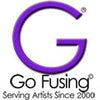
How to Apply Solid Color Enamel Glass Decals
![]() How to Apply Solid Color Enamel Glass Decals
How to Apply Solid Color Enamel Glass Decals
Tips for successful application and kiln firing full color glass decals
We are starting with the basics and then proceeding to ensure successful kiln firing these sheet decals onto glass or a ceramic application. There are close to 30 Solid Color Enamel Decals and you can layer them to create more colors when firing in a kiln.
STORAGE OF ENAMEL DECALS
1. Glass Decals should be stored standing on their edge. Do not compress by stacking on top of one another, pressed in book pages, etc.
2. Decals should be stored at room temperature. Avoid extreme temperature ranges above 80 degrees or below freezing. In addition, avoid high humidity conditions above 60%.
HOW TO PRODUCE THE BEST COLORS WHEN FIRING
APPLICATION USES: Think of full sheets of colored decals as another form of enamel paints. The difference is that you do not have to mix, brush or wait for them to dry. Instead use scissors, shape punches or cutting dies or a favorite paper cutting machines to create the desired shape or design.
Note: If applying a solid color decal onto a transparent glass the decals can will produce a semi-opaque or semi transparent affect. Applying to a solid opaque base of white using a enamel decal of paint 1st will produce more intense colors applied over the white. i.e. Applying a solid color enamel decal to a darker opaque base will make the colors darker.
Consider multiple firings when layering decals or different paints like bubble paints or inclusions. Consider soaking your glass layers longer during the program schedule. An Example: use a slump schedule, but fire the decal at lower temperature to attain your full fuse just kiln fire it longer. This will produce richer colors from your decals as they are not spreading out over a molten glass surface.
Treat these decals like all of our decals (Read How to use Fusible Glass Decals) :
CLEANING YOUR GLASS and HANDS is the most important point to remember. Even oils from your skin can alter the kiln fired results!
1. Kiln Fire your glass to a Full Fuse. If you think about it, glass becomes molten and moves when at a full fuse (average temperature of 1440 to 1450 degrees F). If you are applying a decal between layers of glass or on top and then firing to a full fuse then you have 2 layers of glass moving and whatever is on the surface is moving and stretching too.
2. Use a sharp cutting tool or scissors and leave a small boarder around the decal design.
3. Each water slide decal regardless if its purpose to be use on glass or ceramics comes with a protective sheet cover. This paper cover is like a tissue paper and most of time the time has a protective wax coating on the side facing the decal. This cover is acting as a protective barrier to keep the thin layer of enamel pane from becoming scratched or crackled. We recommend leaving the cover on the decal while you are cutting out the design.
4. Temperature and humidity control is important for storage of your decals. High temperatures can cause the cover to stick to the surface of the enamel paint.
REMOVE THE WAX PAPER PROTECTIVE BARRIER AFTER CUTTING AND BEFORE SOAKING!
5. Use of Distilled Water when soaking the decals is important so you can avoid introducing any minerals to the decal that could interact with the different minerals used to create the colors. Soaking your decal in room temperature water is also recommend to control the release from the paper backing, around 20 to 25 seconds.
6. Tweezers and even a simple toothpick can be handy tools to manipulate a wet, slippery decal.
7. Adding water to the surface of your fused glass can make positioning the decal much easier.
8. Start at the back edge of your glass and slide the decal off the paper backing onto glass. As you gently putt the paper backing away. After you have the decal in the correct location, use the corner of a paper towel to wick away any excess moisture. If you see air pockets under the decal, you can position the side of your finger across the center of the decal and roll to the outer edges; this will push out any air or excel water. A small squeegee (i.e. an old credit card will do) is sometimes useful but it can increase the chances of damaging your decal. Increase the blotting pressure until the entire decal, including the edges, are adhered to the glass.
9. Allow to completely dry. You do NOT want any moisture under the decal when you fire it in your kiln or will steam off the decal and produce undesirable effects.
Layering decals: It is not recommended to layer decals over each other during the same firing. You can fire layer upon layer in different firings! This opens up your creativity to combining colors, designs and will allow you to achieve ad 3D look and shadowing.
READ our Double Slide Technique.
FIRING CONDITIONS
1. Do not fire too long. Tack Fusing produces much better results. Glass & Ceramic Decals are comprised of many colors and some, like reds, are temperature sensitive. LOWER TEMPERATURE, SLOWER and SHORTER SOAK times, not HIGHER TEMPERATURES, FASTER and QUICKER is a good habit to cultivate with most kiln fired art work.
The cure range for Low to Hi-Fire Decals is 1150 to 1325 Degrees F
IMPORTANT TIPS:
2. Kiln temperatures that are too high for too long can also make the colors disappear or come out as a pastel instead of a saturated color.
- Choosing a selection results in a full page refresh.
!
